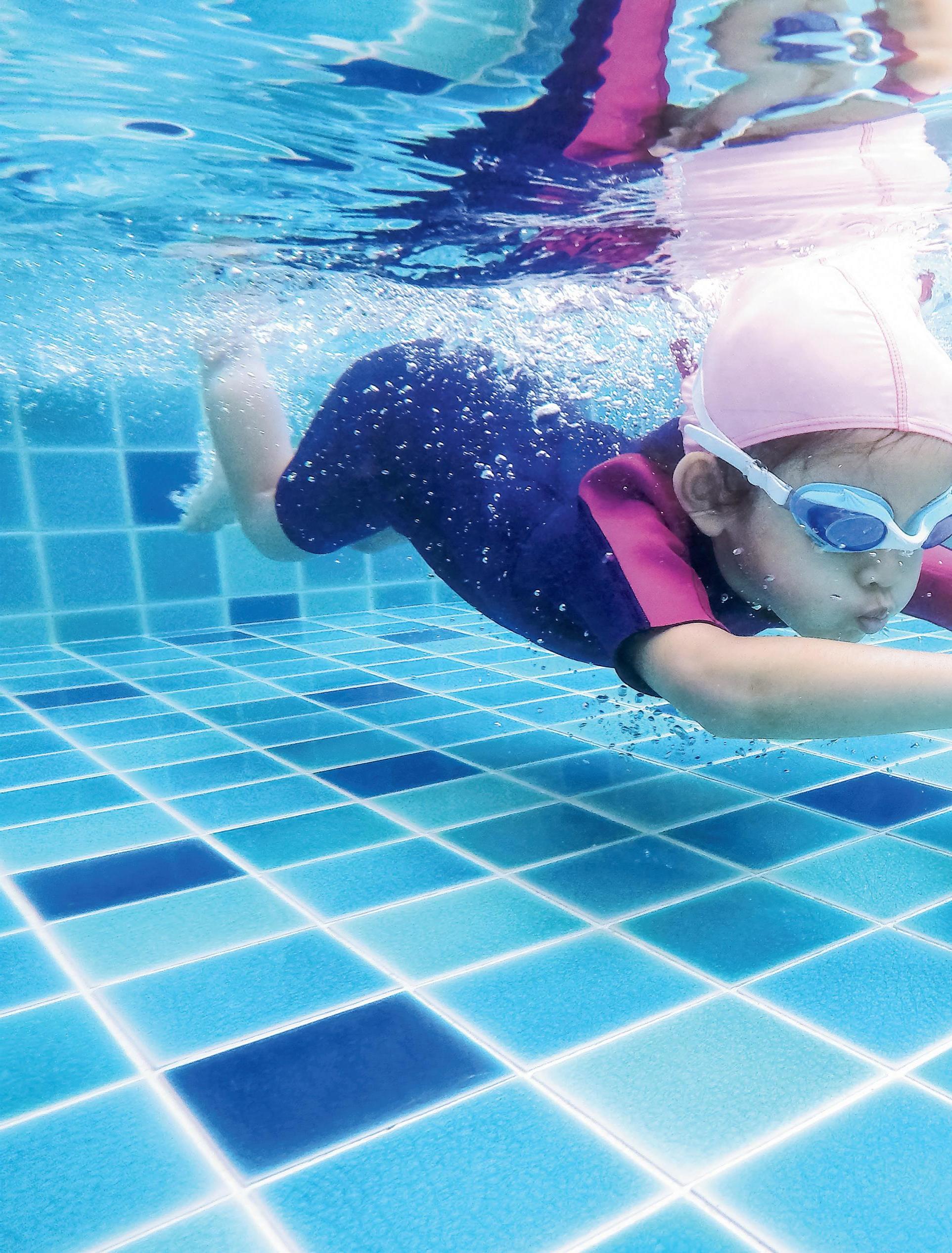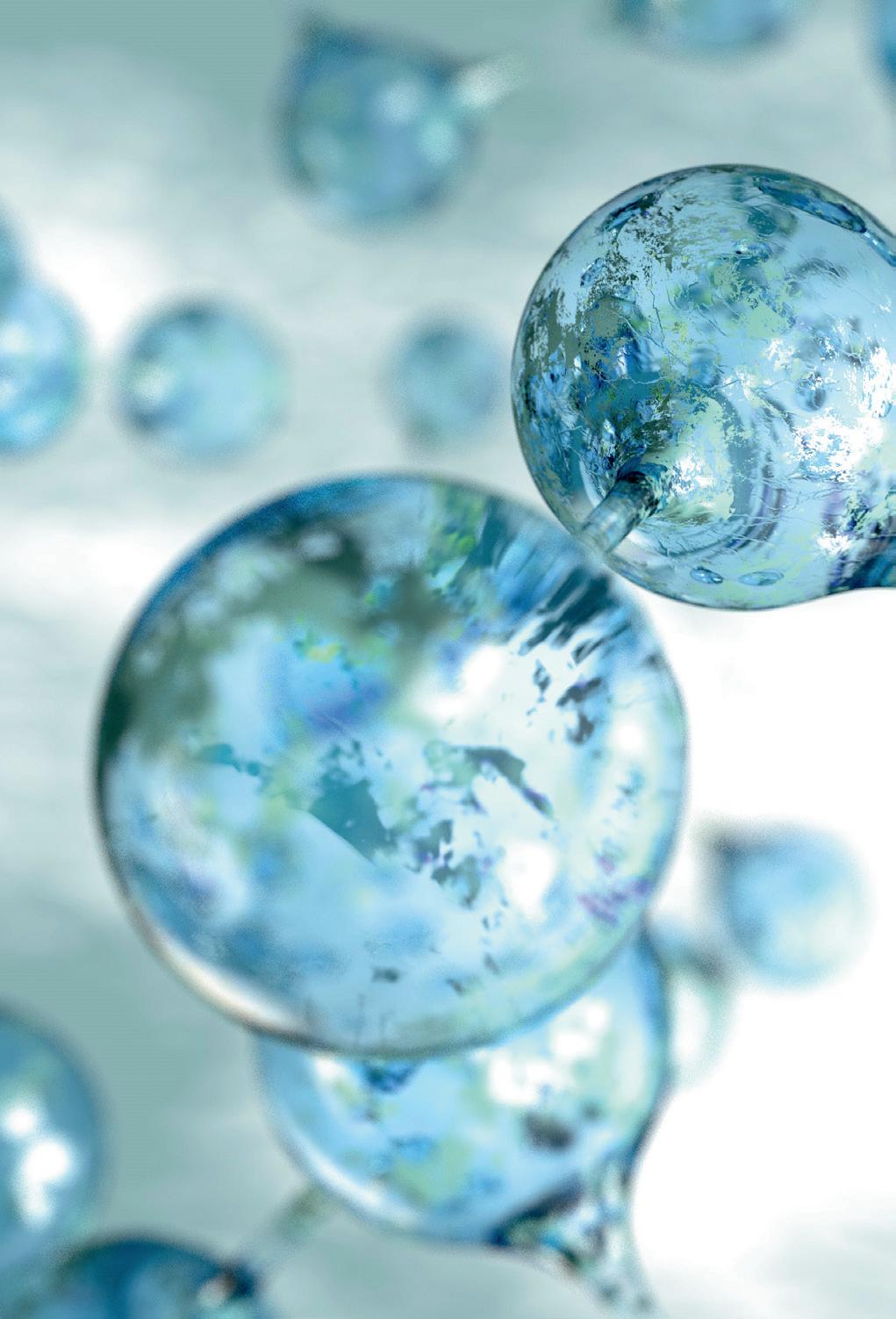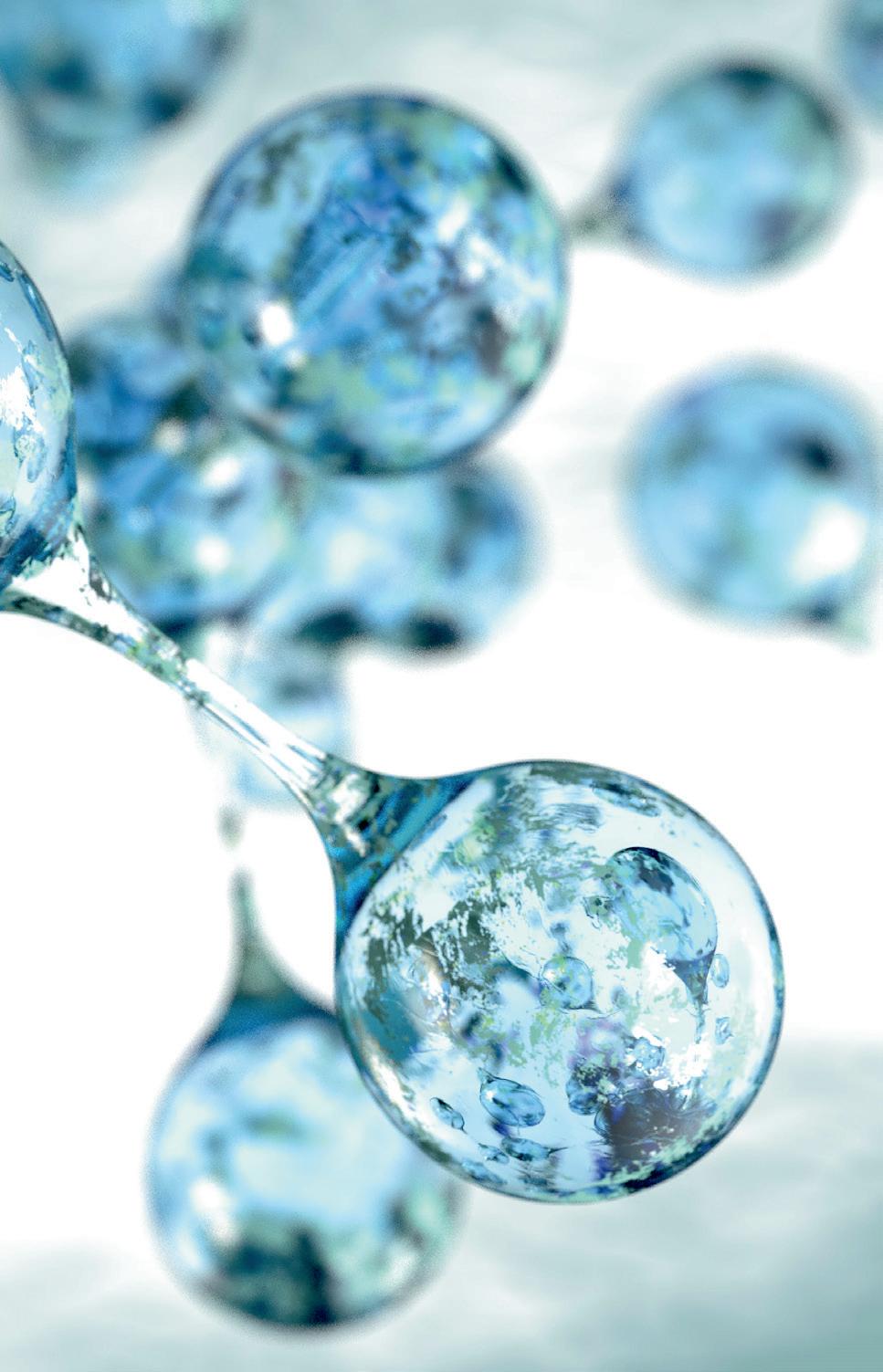
10 minute read
Checks and balances
© Stock.Adobe.com/au/Kawee
CHECKS & BALANCES
WHY WATER BALANCE MATTERS

There’s nothing more inviting than a sparkling clean pool, but looks are only part of the story. Taking steps to ensure your pool water is chemically balanced will save you in the long run, ensuring the sanitisation process is effective and protecting your pool and spa equipment.
Aproperly chemically balanced pool provides a healthy environment for your family and friends. Leaving water untreated can lead to a less than enjoyable swimming experience and potentially risk damage to your pool.
As with most things, the most important factor to maximising the life and appearance of your swimming pool is prevention.
There are three main variables in swimming pool water chemistry that need to be maintained to achieve balance: pH, total alkalinity and calcium hardness.
PH
pH is a measurement of the acidity or alkalinity of a solution — in this case, the pool water. The pH scale ranges from 0–14 with 7.0 representing a neutral state. Values below 7.0 are acidic and above 7.0 are alkaline.
The pH level in pool water needs to be kept within the optimum range to support: 1. the pool shell, interior finish, pipes and operational equipment 2. the comfort of pool users 3. the water sanitisation effectiveness
Australian Standard AS3633 Private Swimming Pools - Water Quality, defines the pH operating range for swimming pool water as between 7.0 and 7.8, with a recommended range of between 7.2 and 7.6 for pools constructed from concrete. In the case of fibreglass pools, SPASA recommends maintaining a pH level of between 7.0 and 7.2, but optimum levels for fibreglass and some interior finishes may vary, so this should be confirmed with your installer or pool shop.
Many things cause variation in the pH level including manually topping up your pool to compensate for evaporation, heavy rainfall, more frequent usage or a large number of pool users (commonly referred to as a heavy bather load) and the addition of chemical products like chlorine.
When pH is low, the water is more acidic. For swimmers, that typically means stinging red eyes and itchy skin, while it can also cause increased bleaching of swimwear. The water suffers too, changing from a clear sparkling blue to a murky colour, requiring more chemicals to balance and adding unnecessary cost. Acidic water can also impact pool pumps and other equipment

as it causes corrosion and shortens service life. It’s also not great for interior finishes, as it may cause imperfections on the surface which can subsequently encourage algae growth.
A high pH level means water is more alkaline. The addition of chlorine stabiliser or a sudden rise in water temperature can both contribute to raised pH levels. Alkaline water is ‘softer’ than neutral or acidic water, which dries out the skin and can cause eye irritations. It also limits the effectiveness of sanitisers. The quickest and easiest method to correct this is to add muriatic acid, otherwise known as hydrochloric acid.
THE EFFECT OF PH ON CHLORINE Effective sanitation relies on maintaining optimal pH levels and should be monitored frequently. Regardless of the chlorine format and chlorination process you use, any pH drift above the Australian standard recommended range (7.0 to 7.8) will inhibit sanitising capability. This may be noticed when attempting to clear your pool and water testing records a high level of chlorine, yet the water is not clear. In this instance, it’s probable that the pH level is high and restricting the chlorine from effectively creating crystal clear water.
TOTAL ALKALINITY
Total alkalinity (TA) is a measure of the total concentration of bases (carbonates, bicarbonates and some hydroxides) and total dissolved

solids (TDS) in water. TDS includes minerals that separate out of pool chemicals, along with dust, skin oils, sunscreen particles — any solids released into the pool water. TA is expressed in parts per million (ppm) or milligrams per litre (mg/L).
The AS3633 Standard recommends a TA range between 60 and 200 ppm. Your pool builder, service technician or pool shop can provide a more definitive recommendation based on the specifics of your pool.
Low TA causes pH levels to become unstable, meaning that small chemical additions will result in increased pH level shifts — a state known as ‘pH bounce’.
Total alkalinity can be altered in the following ways: • The addition of a buffer will raise the TA.
A buffer is a chemical addition (sodium bicarbonate) which will minimise rapid pH level fluctuation (pH bounce) that occurs when acid or base products are added to the water. MAINTAINING WATER BALANCE SHOULD BE SIMPLE AND COST-EFFECTIVE.
© Stock.Adobe.com/au/SmirkDingo • The addition of an acid, such as hydrochloric acid* or sodium bisulfate, will lower both pH and TA. • Topping up the pool water will alter the TA, with the direction being determined by the TA of the top-up water itself.
THE RELATIONSHIP BETWEEN PH AND TA As the addition of acid lowers both pH and TA, there is an interconnection between these two compounds. For this reason, they need to be adjusted together, factoring in the effect one has on the other.
Hypothetically, you have a concrete pool and are seeking to maintain a pH level of 7.2 to 7.6 and TA of 100 to 120 ppm (varies — check with your local SPASA Australia member). You’ve checked the pH level and found it is within range, but the TA reading is low.
You need to add a buffer to raise the TA level at the optimal rate. However, because the buffer is an alkali, it will additionally raise the pH level. The addition of an acid to counter that and lower the pH level will also lower the TA. The solution to this issue is to raise the TA to an artificially high level. This ensures that when acid is added to lower the pH, the corresponding TA reduction falls within the target range. *Safety note: Hydrochloric acid must always be diluted — onepart acid to 10 parts water — before being added to pool water. Follow best practice and always add acid to water, never the other way around.
CALCIUM HARDNESS
In simple terms, calcium hardness is a measurement of the dissolved calcium in your pool water. Referring to AS3633, the recommended range for a domestic swimming pool is between 80 and 500 ppm.
Calcium hardness must be in harmony with pH and TA to prevent damage. Low levels make the water corrosive to both the pool and equipment, whereas high levels lead to scale formation.
Standard pool water test kits can’t be used to measure calcium hardness, so you’ll need to take a water sample to your pool shop for testing. It’s worth noting the use of calcium hypochlorite (a form of granular chlorine) for sanitisation will increase calcium hardness levels, necessitating more frequent testing and adjustment.
A FINAL WORD OF ADVICE
Each pool’s environment is unique and may take some calibration to achieve water balance. Maintaining water balance should be simple and cost-effective, though it can be a process of trial and error. We suggest initially adding chemicals in small volumes, running the filter and testing the effect after several hours. Attempting to affect large level changes using high chemical volumes can have the opposite effect of your intended outcome, potentially causing unnecessary complications and damage to your pool and equipment.
If you are in doubt, you should always err on the side of caution and consult a SPASA accredited pool professional, who can not only provide peace of mind and assist in water balancing, but also provide guidance on the optimal level targets specific to your pool.

WARMER
WATER
Aswimming pool is one of the most significant investments a homeowner can make, and not just from a financial standpoint. A pool can be leveraged for fitness, muscle recovery, relieving stress, entertaining the family and much more, which begs the question — are you making the most of your investment by closing your pool for half the year?
Australia is lucky enough to have the option of various pool heating systems, such as heat pumps, gas heaters and solar heating. However, heating a pool is not quite as simple as installing a heating system and waiting for the water to warm up. There’s much more to it than meets the eye. Factors like climate, aspect and infrastructure all need to be taken into account. Each system has pros and cons that will better suit particular lifestyles and geographical locations.
GAS HEATING
A gas heater is a cost-effective way to heat your swimming pool to a comfortable swimming temperature all year round. Gas heaters are popular due to their quick heat-up times compared to heat pumps, which can take multiple days to heat the pool adequately. Gas heaters are generally available with heating outputs of 14kW to 100kW.
When choosing a gas heater for your pool, you should consider these factors: • Swimming pool size • Maximum desired temperature • Heating time • Your swimming season
HEAT PUMPS
A heat pump is a very energy-efficient heating option for your pool and a great alternative for areas that don’t have a natural gas connection. They use the same technology as reverse-cycle air conditioners, extracting heat from the air and transferring it to water through a series of processes. Heat pumps are typically restricted in their heating capacity as they are reliant on the available electricity in your home. Typically, residential heat pumps will range between 7kW and 25kW.
Similarly when choosing a heat pump, you should consider the following factors: • Geographic location and climate • Maximum temperature • Swimming pool size • Indoor/outdoor location • Your swimming season
The AstralPool range of heat pumps now includes both standard technology and the new inverter technology. Inverter technology allows the heat pump to reach an extremely high COP (Coefficient of Performance) compared to traditional heat pumps. The unique inverter technology reduces the speed of the unit as it reaches the desired temperature, minimising energy consumption and allowing you to enjoy swimming at a constant temperature.
For every 1kW of electricity consumed, AstralPool heat pumps will collect up to 13kW of heat from the atmosphere. Sunshine is not necessary and your heat pump will continue to heat your pool in air temperatures as low as 7 degrees Celsius. Even if the nights are cold, or the days leading up to the weekend are cool, you can rely on your AstralPool heat pump to heat and maintain your pool water temperature.
Visit astralpool.com.au to view our complete range of optimal heating solutions.
ASTRAL POOL
P: 1300 186 875 W: ASTRALPOOL.COM.AU
POOL AND BACKYARD
AUTOMATION MADE EASY
Hayward Pool Products is one of the world’s largest manufacturers of swimming pool equipment. The company is at the forefront of innovation within the pool industry, with a strong focus on energy efficiency, reliability and ease of use over a full range of pool equipment.
Hayward Pool Products pride themselves on offering a great user experience. The company have worked hard to design products that make swimming pool ownership and maintenance easy. Through this they have removed many of the hassles associated with pool ownership.
The Hayward OmniLogic pool and backyard automation system provides an easy

way to control the chemistry of a residential pool and spa, as well as the heating, lighting, water features and any other pool or backyard equipment required by the user.
Hayward OmniLogic brings together all the elements of a modern energy-efficient pool and allows the user to control it with an app, giving users the ability to quickly and simply get their pool running exactly how they like it, whenever and wherever they are. Users can even pre-set their favourite settings, so whether it’s the warm pool and dimmed lighting required for a romantic night in the spa or the bright lights and water features to accompany a party, it just takes the touch of a button.
HAYWARD POOL PRODUCTS AUSTRALIA
P: +61 1300 766 571 E: SALES@HAYWARD-POOL.COM.AU W: WWW.HAYWARD-POOL.COM.AU






